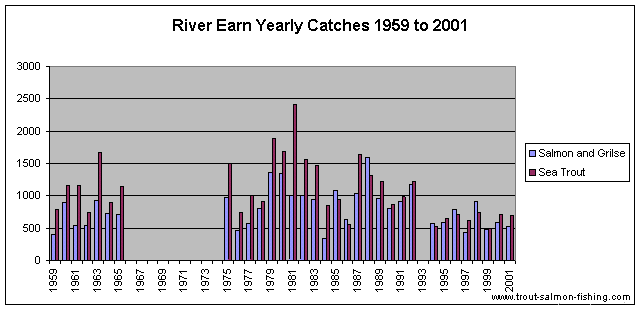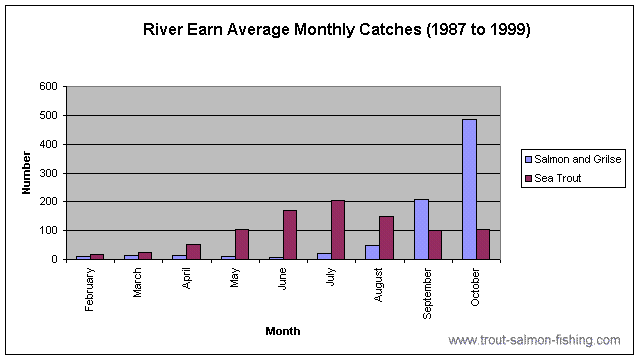|
|
Four Scottish Sea Trout Rivers
River Endrick
The Loch Lomond system, including the loch itself, which at twenty one miles long
and covering an area of 17,500 acres, is Scotland's largest
loch, the major tributaries Fruin and Endrick, and the River
Leven which runs the short distance from Balloch to enter
the Firth of Clyde at Dumbarton, can produce up to 1500
salmon and a similar number of sea trout. Most of the
fishing on the system is managed by the Loch
Lomond Angling Improvement Association, who issue
day, week and season permits.
The main tributary, the River
Endrick, rises in the Fintry hills to flow for
twenty miles westwards via Fintry, Balfron and Killearn and
over the Pots of Gartness before entering Loch Lomond near
Balmaha. At one time one of the premier sea trout fisheries
in Scotland, the runs of migratory fish on the Endrick have
declined dramatically since the mid eighties. Much of the
river can be fished by members of the Loch Lomond Angling
Improvement Association, which is open to all (subject to a
maximum membership limit) for the price of a yearly
subscription. The Association is working hard to reverse the
decline in stocks and applications for membership, which
includes the fishing on Loch Lomond, the River Leven and the
River Fruin, should be directed to tackle shops in the
Glasgow area or online via the association website above.
River Spey
The River Spey is a world
renowned salmon river. It is also one of the best sea trout
rivers in the British Isles. The best of the salmon fishing,
often expensive and much sought after, is to be found on the
lower fifty miles of the river below Grantown on Spey.
Understandably, the superb salmon fishing on the lower
river takes priority over the sea trout fishing. Happily,
the best of the sea trout fishing is to be had upstream of
Grantown, on the twenty miles of the upper middle
river between Grantown on Spey and Aviemore, where much of
the best of the fishing is available to visiting anglers
through two Spey
Angling Associations, with an additional beat of
about three miles in length available for private let at
Kinchurdy, not far above Boat of Garten.
In past decades, this
twenty miles of river would see an annual recorded catch of
anything up to 2000 sea trout. Catches have declined in
recent years, not least I suspect because of the apparent
general loss of interest in night fishing and the
consequent fall in the number of visiting sea trout anglers.
The Spey, however, can still provide excellent
sea trout sport for those prepared to fish
through the short summer nights.
River Earn
The River Earn flows
eastwards from Loch Earn to join the Tay estuary just south
of Perth. It is joined by several tributaries on its way,
most notably the Water of Ruchill, which is one of the few
tributaries unaffected by either Hydro-electric schemes or
water extraction. The Earn is an attractive medium sized
river offering trout, grayling, sea trout and salmon fishing
throughout its length, some through fishing clubs like those
in Crieff, Comrie, Auchterarder and Dunning.
Access, however, to the salmon
and sea trout fishing on the Earn is far from
straightforward, with around 40 riparian owners throughout
its length. The Earn has a late salmon run, mainly in
September and October. Sea trout are worth pursuing from May
onwards, although numbers have declined in recent seasons. A
normal year would now see in the region of 600 sea trout
caught throughout the river and a similar number of salmon.
The graphs below, although not quite up to date, give an
idea of expected catches.


Grayling fishing can be had
throughout the river from November to January, on both club
water and estate water. Permits are available to visitors
for the stretches managed by the Comrie
Angling Club and Crieff
Angling Club. Dupplin Estates at
Forteviot issue trout and grayling permits. Permits are also
available for trout salmon and grayling fishing at Kinkell
Bridge, near Auchterarder.
Border Esk
The Border Esk is formed by
the meeting of the Black Esk and White Esk near Bailiehill.
On its way to Langholm, the Border Esk is joined by
tributaries Meggat Water, Ewes and Wauchope and, just
downstream of Langholm, by the Tarras Water. Just below
Canonbie, the Esk is joined by its major tributary, the
Liddel, a good salmon and sea trout river in its own right.
At Scotsdyke, the Esk, hitherto a Scottish river, enters
England and flows on past Longtown to meet the Solway Firth
near Gretna. Renowned as one of the best sea trout rivers in
the country, the Border Esk also has a good run of salmon
through the latter part of the season.
The Esk and Liddel fishery beats
were once among the most productive in the country, and
might produce around 5000 sea trout in a season, many of
them taken on the night fly during the short summer nights
of June and July, with the added bonus, towards the end of
the season, of up to 500 salmon. For reasons that are not
clear, catches of sea trout on the Border Esk, like those of
other Solway rivers, have declined in recent seasons, with
the Buccleuch Estate beats now producing somewhere between
500 and 1000 sea trout per season and around 200 salmon.
Given the right conditions, though, June and July can still
provide some excellent night fishing. An impressive 2012
catch return of 198 salmon and 980 sea trout was the best in
10 years and if sustained, bodes well for the future.
Much of the available
fishing on the Border Esk and Liddel, known as the Esk and
Liddel Fisheries, extending to some twenty miles of fishing,
is owned, and was managed for many years, by the Buccleuch
Estates, with day, weekly and season permits being made
available to local and visiting anglers at reasonable cost.
From the beginning of the 2012 season, the fishing is to be
managed by a new local angling club, which has secured a ten
year lease of the “association†waters from the estate.
Permits will be made available to locals and to visiting
anglers in much the same way as before.
Border
Esk and Liddel Angling Club
The former Esk and Liddle
Fisheries beats, now managed by the recently formed Border
Esk and Liddel Angling Club, include some of the
best fly fishing water on the middle Esk and the middle and
lower Liddle. The Club is a not for profit association open
to locals and visitors alike, the objects of which are to
promote the sport of angling and in particular protect,
improve and develop the Rivers Esk and Liddel from its
confluence to its head waters and all the tributaries as a
facility for fishing, to help to maintain these rivers and
improve biodiversity for the benefit of the public and to
promote enjoyment of the river by the general public and in
particular to take specific action to promote the sport of
angling amongst young people and people with disabilities.
In addition the club recognise the contribution angling can
make to the economy of local communities. To this end the
club have engaged with a range of local businesses to
discuss what the Club might do to encourage tourists and
visitors to the area.
It is worth noting
here the unresolved controversy over the recent actions by
the English Environment Agency to impose an English rod
licence on anglers fishing the Scottish beats of the Border
Esk. In protest at this wholly inappropriate, and legally
questionable, action by the Environment Agency, many Esk
fishers, to their credit, refused to take permits on the
river, much to the detriment of the river and the local
economy. It is to be hoped that a reasonable compromise can
be reached on the matter and that normality might soon be
restored to this once great sea trout river. |